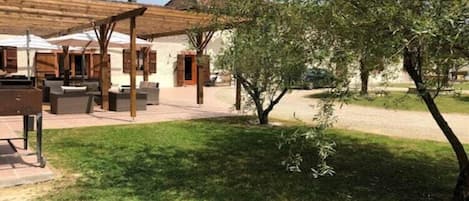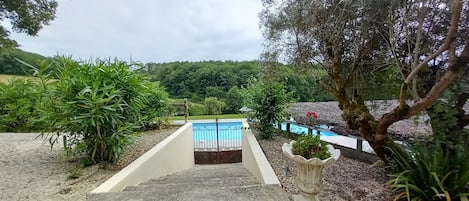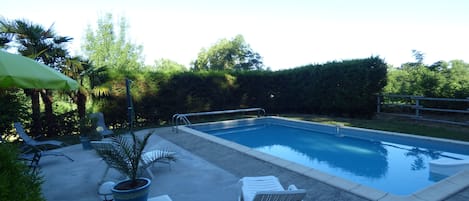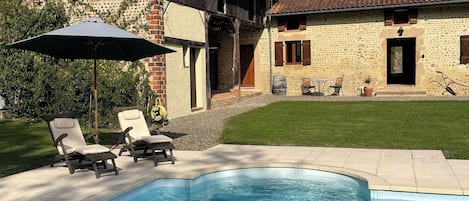We invite you to experience exceptional moments with us at Maison Manechal rated 5 épis "Prestige" accommodation from Gîtes de France.
Maison Manechal is an early-19th century wine house, built to supply the French army with rough red wine. The very big room with the huge walnut beam in its centre was the chai, where the wine was pressed and put into barrels. It now houses a vast fireplace, a cosy place to be in winter. To the front, the house presents a formal stone façade, smothered in roses in May-June. To one side the little ‘pizza hut,’ covered in old canal tiles, houses a large barbecue (with a wind baffle to stop smoking) and a bread-pizza oven, which if stoked up to a high heat over many hours makes excellent pizzas. The large table there has seen many a happy gathering.
To the rear the house looks quite different, its twin towers framing a terraced croquet lawn with four large cypress trees where the yearly village championship is held, won last year by the mayor. Beyond, open fields, once the vineyard, sweep down to woodland.
To one side, off the kitchen, the upper terrace is a suntrap in the morning, a perfect place for breakfast, fresh croissants and pain au raisin bought in the wonderful Boulanger in Rabastens de Bigorre and fresh fruit picked from the many fruit trees in the demesne. And then a few steps down on the lower terrace, raised up above the surrounding fields, is the swimming pool (12x6m) which is salt-based, a kinder alternative to chlorine. The far right-hand corner catches, in summer, the last rays of the dying sun, surprisingly hot for 9 o’clock at night. A good place to sit and have a sundowner! Sun loungers and deckchairs are stored in the left-hand tower as you go down the steps. In the right-hand tower are the pumps and controls for the pool.
Another spot for breakfast on really hot days is around the huge oak table in the ‘Pirates Den’ — open to one side outside the chai. The slanting sun is filtered by the wisteria and roses which smother the old beams. With candles lit at night, it is a romantic dinner venue. Above it, up the winding oak and chestnut stair, is an oak-floored gallery for playing table tennis. Boules can be played in the large expanse of gravel in the courtyard. Another game, a bit like quoits but using square wooden batons, is played on the ‘chapiteau’ terrace, the lawned, raised area about the size of a tennis court beyond the swimming pool.
A Walk around the Village – and a little bit of History
Monfaucon sits on a long ridge formed by the grinding of ancient rocks as glaciers scoured their way from the Pyrenees to the sea at Bordeaux. Manechal sits half way down one side of this ridge. A walk around the village is a succession of steep climbs and descents – very good for the cardiovascular system. Turn left out of the gates and down the hill you will go past the house of Claude Laniesse, our famous potter, the only living ceramicist to have had an exhibition at Sevres Museum in Paris, whose exquisite garden has featured in many glossy magazines. If the gate is open you are free to go in and look at his exotic wares, but beware you will be tempted to buy these fabulous creations. You will, though, have to speak French. Next door is the long-serving and always helpful mayor, Roland Dubertrand, who lives in the oldest house in the village. At the cross at the bottom of the hill retrace your steps up rue de la Mongie and climb up the hill past Manechal and turn left at the little crossroads at the top. This takes you to the old heart of the village, now a shadow of its former self. The Monfauconnais – the denizens of the village of Monfaucon – have witnessed more than a bit of history over the centuries.
Continue up past the church to the very top of the ridge. This is where the old ‘citadel’ once stood. It was sacked by the Black Prince, the half-English, half-French eldest son of Edward III in the wars between England and France in the 14th century – for centuries Gascony was part of England. Turn back and pause to look at the church. In the 16th century, when Monfaucon was a protestant stronghold like so much of the region, the village was attacked by the Catholic forces and the old church razed to the ground. In between, and for more than a century afterwards, the Black Death wrought havoc, and the ‘new’ church you see in front of you was redecorated in the 1780s in a glorious swirl of baroque carving in gilt and blue as a thank you for the final cessation of the plague. It is well worth a visit and the key is held by one of the villagers. Notice the old wooden funeral bier in a corner, covered in a black velvet pall embroidered with skulls and crossbones, used to wheel the coffin to its final resting place. Open the semi-circular blue doors opposite the main door and the old font is revealed, a wonky wooden dove suspended by a wire above it.
There is a little laneway beside the church heading higher still. Go up the lane past the old presbytery and stand beside the stone cross in front of a little mortuary chapel and look over the edge of the steep escarpment in front of you. In 1814 a young English officer stood on this spot and observed the advance of the English troops through the vineyards in the plain below him in pursuit of the forces of Napoleon’s Marechal Soult (appointed a few years before to command the ‘Army of England’ post the invasion, which never happened) as the French troops were harried from Spain to their eventual final defeat at Waterloo. On good days you can see a breathtaking panorama of the mighty Pyrenees rising up from the plain, stretching to the Atlantic to your right and to the Med to your left. The vineyards in the plains have now vanished, apart from a few parcels for private consumption, to be replaced by wheat, maize and sunflowers, the vines decimated by the outbreak of disease in the late 19th century.
If you continue down the lane past the old chapel the lane disgorges into a field and at the end of a slight depression in the ground marking the old road you will spot some tumbledown stone pillars. This is the entrance to the old graveyard and the site of the old church. It is a haunting place. Amongst the overgrown trees and old box hedges which once delineated paths – there were burials here amongst the forebears of ancient families until the early 20th century – old bones and the occasional skull, dug up by foxes or badgers, lie strewn.
Returning past the church and back down the hill, the Mairie and the primary school occupy the corner site. There is a tennis court in the school grounds which can be used by villagers and their guests. As you return to Manechal you are probably struck by the lack of houses, and the disjointed nature of the village, houses strung out along a fan of roads. After centuries of war, famine and the plague, 18th and early 19th- century Monfaucon was relatively prosperous. The slaughter of the First World War depopulated the village, and that and the agricultural depression which followed it, caused the village to shrink dramatically. With no natural stone for building, except the round stones of the river beds used to such great effect in the houses of the plains and the Pyrenees, the local houses are largely built of mud blocks and once the roof is breached, the house literally melts back into the soil. The village now has only half the houses standing that existed in the 1920s.
Today it is a peaceful, friendly village, the majority farmers whose names have studded the war memorials and the village records for centuries.
Further Afield
Turn left out of the gates and at the cross at the bottom of the road turn left again and carry on past the village fishing pond to the main road and turn right and you will reach Marciac, famous for its summer jazz festival, a beautiful bastide town with an arcaded main square which is home to a variety of bars and restaurants. One of our favourites is Cafe Zik, its large wooden deck overlooking the lake, just outside the town. Opposite it sits La Peniche, a huge river boat marooned on the lake (how did it get there?) which offers less sophisticated, traditional Gascon fare. This is the land of duck, and foie gras and duck breast, cassoulet and confit de canard are staples. The white wines of the region are little known, and delicious. Originally always sweet, the vins secs are now much more popular. Gascon wine can be cheap, but is still very drinkable, slightly fruity but with a refreshing zing from the Manseng grape. The more sophisticated (but still not expensive) varieties are Pacherenc du vic Bilh, Jurancon and the various wines made by the St Mont Cooperative which are really very good. The tradition is to drink sweet white (doux or molleux) with foie gras or as an apero. The reds are another story. Largely based on the Tannat grape and with the appellation Madiran, the cheaper wines can be almost undrinkable. The rule is never drink them under four years old. The more expensive can be delicious, strong, beefy reds. On summer Sundays Chateau Viella nearby stages exquisite tasting feasts, with a different wine with each course. Le patron, M Bertolussi, will take you through the vines beforehand to educate you about the local wines and will pop up between courses to introduce each new bottle. The chocolate pud is accompanied by an astonishingly delicious sweet red wine. Around Madiran , about twenty minutes away, there are many small wine houses which open their doors to visitors to view the caves and taste their wines.
For really sophisticated dining La Rive Droite is a ‘restaurant gastonomique’, once patronised by Victor Hugo and Georges Sand, in Villecomtal-sur-Arros, a fifteen-minute drive away. In Maubourguet, once the headquarters of the Duke of Wellington, a twelve-minute drive in the opposite direction, there are a number of bars and eateries under the canopy of the huge plane trees which shade the main street.















